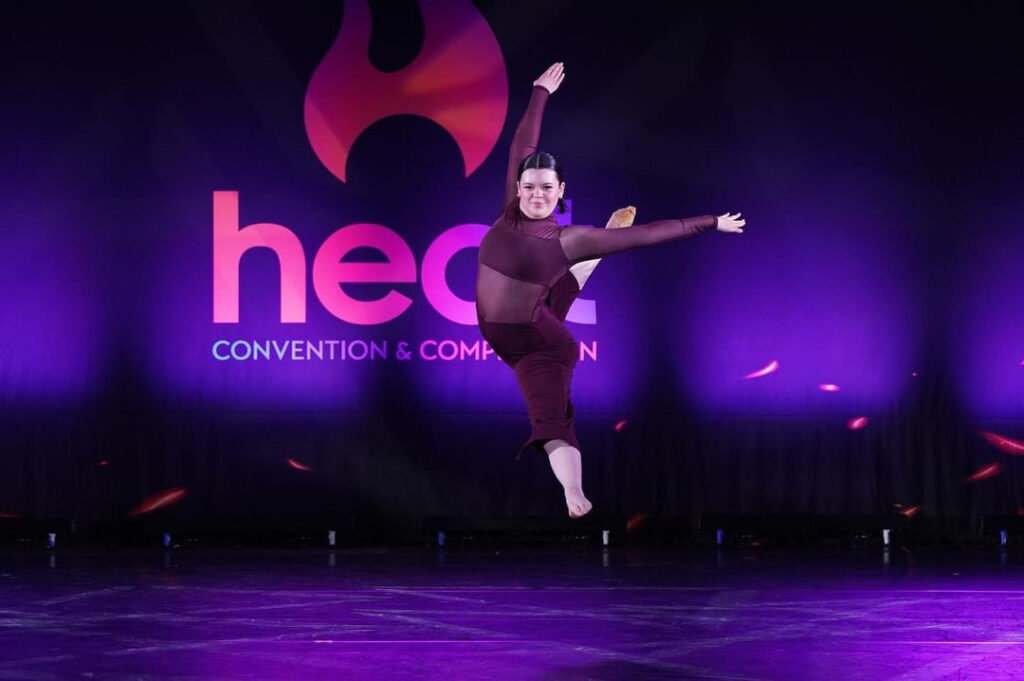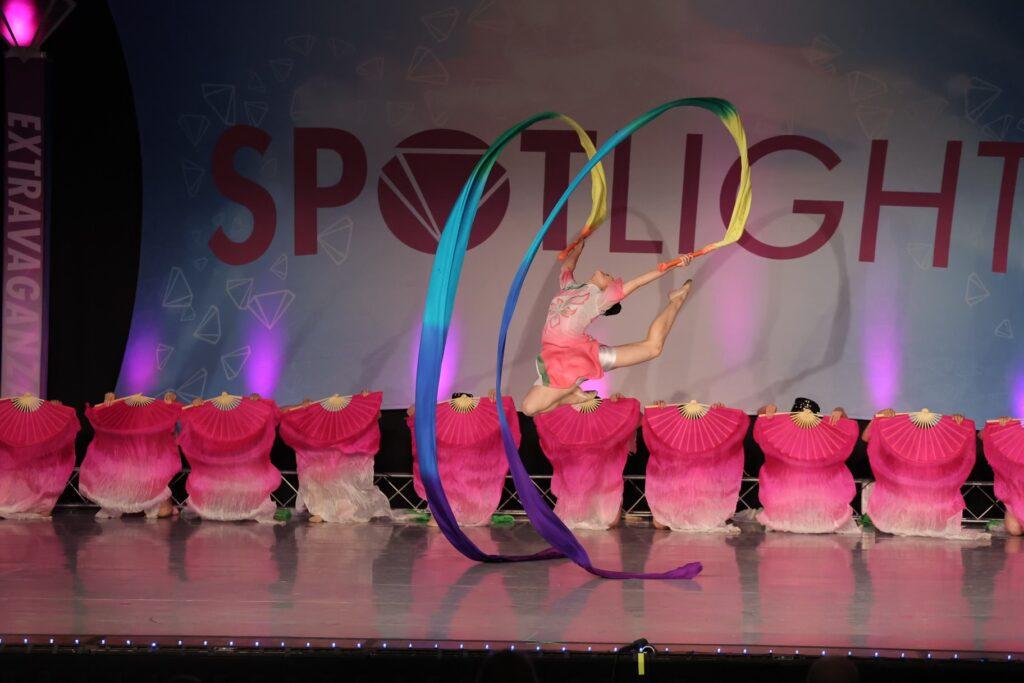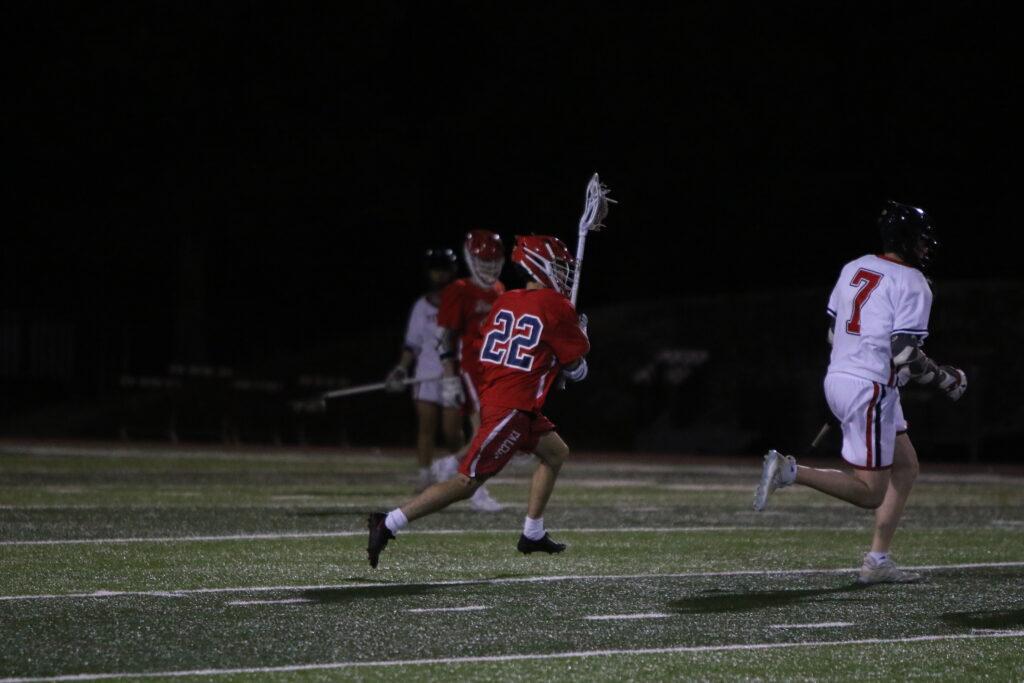Sophomore Ashley Xu and her fellow studio dancers held their fans and ran to the back of the stage, transitioning into the next section of their Chinese folkloric routine. Xu gripped her 10-foot-long rainbow ribbons in her hands and took a deep breath to ready herself for her upcoming solo section. The music changed and Xu sprang out, throwing her ribbons into the air to wow the audience and judges, as the rest of the team formed a wall of rippling pink fans in the back.
Xu has been dancing for 12 years and currently dances on Team 2 — the highest-level team — at her studio, Jun Lu Performing Arts (JLPA).
Last year, when entering the school as a freshman, Xu had the option to choose whether to audition for the dance team or stay at her studio, since committing to both would be too time-intensive. Ultimately, Xu decided to stay at her studio, feeling as though it was better fit for her. For her, and others who made the same decision such as junior Katie Berger, outside studios offer greater resources and solo opportunities, a larger selection of dance styles, participation in more diverse dance events and more freedom to pursue what they are personally interested in.
“I don’t really enjoy doing the styles the school team does and I don’t fit them either,” Xu said. “I’ve been at JLPA for so many years that I already feel like an established member in the team and studio. Also, the training schedule of JLPA aligned better with mine, since most of the school team’s training happens right after school, which is a time I want to keep open.”
Given that the studio specializes in Chinese folk dance, Xu has taken classes there since early childhood, learning to use cultural props like fans, handkerchiefs, ribbons, silk scarves and embroidery hoops.
However, the studio also allows dancers to experience western styles of dance as well. In the beginning, Xu started with styles like jazz, which relies on a dancer’s power and ability to perform sharp movements with high energy. Recently, she has been experiencing more complex styles like contemporary and ballet.
“My favorite style is contemporary because the abstract movements allow such a wide range of dances,” Xu said. “Since there are so many variations of contemporary and it incorporates so many styles, I can use my body in a diverse amount of ways to express my emotions.”
Xu has also been competing in large and small group dances since she was little, and a few years ago began competing in solo dances. In contrast with the school dance team, where only seniors are granted solos to compete with, the system at JLPA allows Xu the opportunity to receive a solo with the style of her choice. Doing dances of different types gives Xu a more immersive experience, as she feels that each offers slightly different challenges.
“Performing a solo is more of an individual challenge, since you experience everything on your own and in your own style. However, since the judge’s focus is directed solely on you, every mistake you make is enlarged,” Xu said.
Every year, Xu’s competition season — spring semester through summer — consists of several regional competitions for group and solo dances with one mandatory national competition in the summer either in Los Angeles, Las Vegas or San Diego to conclude the season.
Every year, JLPA tends to go to a different set of nationals and an assortment of new and old regional competitions, allowing dancers to experience the different structure of each competition, Xu said.
During the 2023 competition season, Xu competed in five regional competitions and two nationals with two group routines and one solo. For regional solos, she completed her folkloric routine “The Falling Rose” three times, which placed first and second at Spotlight Dance Cup in March and May and received third and Miss Teen Dance at Kids Artistic Revenue (KAR) in May. For nationals, Xu competed in KAR and Spotlight nationals, winning 18th in solo and third in a folkloric group routine “Colorful Joy” at Spotlight.
Xu also works with multiple teachers every week, while the dance team sticks to one coach, granting Xu more exposure to the unique aspects of dance that different teachers have to offer. Her main teacher Jun Lu — the owner of JLPA and an expert in the Chinese folkloric dance field — coaches all of her routines.
Xu has worked with many well-known individuals in the industry through guest teacher masterclasses such as former international ballet winner Miko Fogarty and Youth America Grand Prix (YAGP) judge Carlos Dos Santos. In addition, every year, Xu has a new choreographer for her solo, and most recently, Hollywood Vibe 2022 senior best dancer of the year Ceci Sun choreographed her solo “Daydreamer” for the season of 2024.
So far, Xu intends to continue her dance pursuits in the future through small events or activities in college, but not to the extent of a professional path. Competitively participating in an outside studio gives Xu a boost in college, since she feels that the resources at well-established studios are more abundant.
Ultimately, Xu said she finds the types of teachers, dance styles and choreography are what convinced her to stay at JLPA.

Courtesy of Katie Berger
Katie Berger does a firebird jump during her jazz routine “Moderation” at the Heat Convention & Competition nationals on July 10.
Berger, who currently trains competitively at Dance Academy USA (DAU), has similar reasons as Xu for choosing her personal dance studio over joining the school dance team. Having started dancing in Colorado at the age of 4, Berger is now on six competitive teams — each team representing a different routine for competitions.
“I’ve learned a lot of teamwork and perseverance since I’ve had to work on so many challenging, different pieces with my teammates,” Berger said.
Berger chose to stick to the outside studio route because she had already put significant effort into DAU and still sees many future opportunities there to learn a variety of styles including ballroom, ballet, contemporary, hiphop and jazz. Three of those styles aren’t offered on the school team — ballroom, ballet and contemporary.
The DAU system also opens more opportunities for soloists than the school team; although seniors automatically qualify for solos in both teams, dancers at DAU can also qualify for a solo if they receive a scholarship to go to Nationals, which is how Berger has received solo routines.
Another major difference between the school team and DAU are the events offered, Berger said. DAU’s selection of competitions and conventions reflects the unconstrained nature of JLPA’s system, where both studios have more flexibility to participate in different events, while the school dance team participates solely in the USA Dance Competition.
Berger usually partakes in three main conventions — Heat Convention & Competition, Hollywood Vibe and Hollywood Connection, along with attending various competitions such as Spotlight and Encore. At conventions, dancers take masterclasses and workshops of various styles, which is an aspect that the school team isn’t involved in.
Both dancers said they feel the Saratoga dance team and outside studios like JLPA and DAU each offer unique benefits and opportunities. They feel that the school team is confined to a certain structure, while outside studios allow more freedom and range in what they want to pursue.
“The community at DAU is really great,” Berger said. “There’s a ton of team building which I think is super important when you’re doing something competitive, and I’ve made a lot of lifelong friends there.”



























